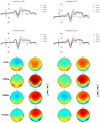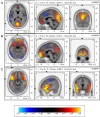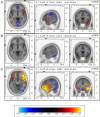Effect of altitude on the spatiotemporal signal characteristics of inversion face recognition
- PMID: 40659743
- PMCID: PMC12260024
- DOI: 10.1038/s41598-025-10442-y
Effect of altitude on the spatiotemporal signal characteristics of inversion face recognition
Abstract
High-altitude environments, can significantly impact cognitive functions, yet the neural mechanisms underlying altitude-induced changes in face recognition remain largely unexplored. This study aimed to examine the impact of high-altitude hypoxia on face recognition processes, with a specific focus on the modulation of the face inversion effect in event-related potentials across different altitude levels. A total of 120 participants were recruited and divided into four groups based on altitude: 347 m (low-altitude control), 2950 m, 3680 m, and 4530 m (high-altitude groups), with 30 participants in each group. Electroencephalography (EEG) was used to record brain activity, and event-related potentials components (P1 and N170) were analyzed to assess the effects of altitude on face processing, particularly regarding the face inversion effect. A significant altitude-dependent reduction in P1 amplitude was observed, with the 3680 m and 4530 m groups showing significantly lower amplitudes compared to the 347 m group (p < 0.05), and inverted faces elicited greater P1 amplitudes than upright faces (p = 0.035). N170 amplitude was significantly more negative for inverted faces compared to upright faces (p < 0.001), while the 4530 m group exhibited earlier N170 latencies than the other altitude groups (p < 0.05), suggesting possible neural adaptation to chronic hypoxia. The sLORETA results revealed progressive temporal lobe reorganization: the 4530 m group exhibited enhanced activation in superior temporal gyrus during inverted face processing, contrasting with diminished responses at moderate altitudes (3680 m). These findings provide neurophysiological evidence that high-altitude hypoxia significantly modulates face recognition processes, particularly the face inversion effect. The observed altitude-dependent alterations in ERP components suggest that hypoxia impacts both early sensory encoding (P1) and higher-order configural processing (N170).
Keywords: Event-related potentials; Face inversion effect; High-altitude hypoxia; Holistic processing; sLORETA.
© 2025. The Author(s).
Conflict of interest statement
Declarations. Competing interests: The authors declare no competing interests.
Figures




Similar articles
-
Aging alters face expressions processing and recognition: insights on possible neural mechanisms.J Neurophysiol. 2025 Aug 1;134(2):543-558. doi: 10.1152/jn.00237.2024. Epub 2025 Jul 1. J Neurophysiol. 2025. PMID: 40590789
-
Short-Term Memory Impairment.2024 Jun 8. In: StatPearls [Internet]. Treasure Island (FL): StatPearls Publishing; 2025 Jan–. 2024 Jun 8. In: StatPearls [Internet]. Treasure Island (FL): StatPearls Publishing; 2025 Jan–. PMID: 31424720 Free Books & Documents.
-
Neural responses to perceptual and sexual ambiguity in facial images: an ERP and time-frequency analysis.Sci Rep. 2025 Jul 7;15(1):24272. doi: 10.1038/s41598-025-07754-4. Sci Rep. 2025. PMID: 40624073 Free PMC article.
-
Levetiracetam add-on for drug-resistant focal epilepsy: an updated Cochrane Review.Cochrane Database Syst Rev. 2012 Sep 12;2012(9):CD001901. doi: 10.1002/14651858.CD001901.pub2. Cochrane Database Syst Rev. 2012. PMID: 22972056 Free PMC article.
-
The characteristics of event-related potentials in generalized anxiety disorder: A systematic review and meta-analysis.J Psychiatr Res. 2025 Jan;181:470-483. doi: 10.1016/j.jpsychires.2024.12.016. Epub 2024 Dec 6. J Psychiatr Res. 2025. PMID: 39675130
References
-
- Sitko, S., Cirer-Sastre, R. & López Laval, I. Effects of high altitude mountaineering on body composition: a systematic review. Nutr. Hosp.36 (5), 1189–1195 (2019). - PubMed
-
- Miguel, P. M. et al. Prefrontal cortex dopamine transporter gene network moderates the effect of perinatal hypoxic-ischemic conditions on cognitive flexibility and brain Gray matter density in children. Biol. Psychiatry. 86 (8), 621–630 (2019). - PubMed
-
- Bekker, A. et al. Physostigmine reverses cognitive dysfunction caused by moderate hypoxia in adult mice. Anesth. Analg. 105 (3), 739–743 (2007). - PubMed
MeSH terms
LinkOut - more resources
Full Text Sources

